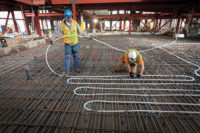Chris Laumer-Giddens has always loved figuring out how things work, which has served him well throughout the duration of his career. He started out in his stepfather’s construction business, later earned an architecture degree, and eventually branched into designing cutting-edge HVAC systems.
Today, he is half of a duo that offers one-stop shopping for customers seeking to build or retrofit high-performance homes. The other half of the duo is his wife, Jodi Laumer-Giddens, whose background is in anthropology and architecture. Their company, LG Squared Inc., is based in Atlanta.
“Jodi went out on her own to start LG Squared in 2006, and I joined a little over two years ago,” Chris Laumer-Giddens said.
Together, the husband-and-wife team offers residential HVAC design, building enclosure consulting, construction, architecture, and interior design services — all with an emphasis on structural performance.
When the pair takes on a project, they share the workload, but each focuses on their specialties and disciplines. “From design through construction, we’ve split it up between the two of us,” Chris Laumer-Giddens said.
Jodi Laumer-Giddens explained, “I usually head up the architectural design of the projects while Chris handles the structural and building science side of it, though we’re both trained in each of these areas.”
It has been exciting to create a company that utilizes all of their talents, she added. While the majority of their projects have been located near their home base in Georgia, they have worked on homes in the Northeast, California, Toronto, and the Bahamas. Approximately 20-30 percent of LG Squared’s work is in renovation and remodeling, and the rest is new construction.
One-stop Shop
Describing how the company operates, Jodi Laumer-Giddens said, “Both Chris and I meet with the homeowners in order to gain a full understanding of their needs and desires for their new or renovated home.”
After the kick-off meeting with the client, she continued: “Chris and I review our notes to determine some of the guiding concepts for the project, which include the size and style of the home, the HVAC requirements, and any site restrictions or obstacles. Together, we decide the type of construction and what the HVAC needs will be, the location of the building on the site, and if we think there will be any code restrictions standing in the way of execution.”
Clients who choose LG Squared to design their homes benefit from the duo’s integrated approach. As Jodi Laumer-Giddens creates the home’s architectural plans, her husband models it for efficiency.
She added, “Chris lays out the foundation and framing with the HVAC system in mind, so there are no conflicts between the HVAC equipment and the structure.”
While they have offered their design and consulting services since the company’s inception, the Laumer-Giddens intend to start building some of the homes they design this year. “We expect to break ground on our first design-build project in October,” he said.
Innovative HVAC Design
Although Chris Laumer-Giddens started in the business as an architect, he expanded to HVAC design because he saw a need for this expertise in the home-performance market. When it comes to mechanical systems, he said, “I’m largely self-taught.”
But he also credited his mentor, David Butler, a building systems engineer, with really helping him to understand the comprehensive design process for HVAC systems.
Chris Laumer-Giddens started out designing conventional HVAC systems. As he gained experience, he began to specialize in mini-split or variable refrigerant flow (VRF) systems — both ductless and ducted — for residential and commercial applications.
“Generally, people think of mini splits as only serving one room — the bonus room, the apartment over the garage, or the small addition,” he said.
But the systems he is designing break this stereotype while taking advantage of inverter-compressor and VRF technologies that mini-split heat pump systems offer.
“These are whole-house systems that are fully ducted and serve more than one room with longer duct runs than the manufacturer-recommended 10-foot maximum,” he said, adding that they just finished a 7,000-square-foot home installed with this type of system that included duct runs exceeding 20 and 30 feet.
According to Chris Laumer-Giddens, you have to know what you’re doing to design this type of system.
“We’ve done a lot of work with, and really understand, mini-split systems and VRF technology,” he said. “People are now seeking us out because they’ve done the research and see the benefits of mini splits and having a third-party design.”
He added he works closely with mini-split manufacturers, including Daikin and Mitsubishi, to provide feedback from the field and to help improve some of the design and technology as homes become more and more efficient. Although the high-performance industry, including a few mini-split manufacturers, is trying to move away from ducted systems because of the challenges with installation and loss of efficiency, Chris Laumer-Giddens believes a ducted mini split is the best way to achieve efficiency while taking into account aesthetic and visual considerations.
As he put it, Americans are not familiar with or used to ductless systems, so they do not want to see “wall warts” (wall-mounted ductless units). But, with a ducted mini split, Chris Laumer-Giddens said, “You really can have your cake and eat it, too.”
Lance Beaton, owner of Vis Viva Energy and Services, is an HVAC and home-performance contractor also based in Atlanta. He has installed homes with systems designed by Chris Laumer-Giddens and is a self-proclaimed “big fan” of ducted mini splits.
“I’ve always liked working with Chris,” Beaton said, noting that he is good at communicating with homeowners and builders to make the case for the efficiency of these systems.
One of those builders is Luis Imery, owner of The Imery Group, a general contractor in Athens, Georgia.
“My company is a specialty builder that focuses only on high-performance homes,” Imery said, adding that he has worked with Chirs Laumer-Giddens on several high-profile projects.
“In terms of the HVAC design and consulting, I would say he is the best in the region,” Imery continued. “Chris is very talented and detail-oriented when it comes to suggesting HVAC design, and he’s always on the cutting edge of the industry.”
Collaborative Process
Working with progressive companies like The Imery Group and Vis Viva presents wonderful opportunities for collaboration, Chris Laumer-Giddens said. “The biggest opportunity we have is collaboration. Much of the building industry tends to view trades as separate, and most trades prefer to be left alone to do it the way they’ve done it for decades. Collaborating early and often has always proven to be the most effective approach to any solution.”
Jodi Laumer-Giddens agreed, noting this is evident in how the team works together as the two halves of LG Squared.
“It’s exciting to have formed a company that offers what we do; not many architects understand the building science aspect of buildings, and not all building science experts appreciate the goal of architecture as it relates specifically to a client,” she said. “The growing interest in having a home that is not only aesthetically pleasing but [also] efficient and healthy has really given us a chance to showcase our combined talents that we bring to our projects.”
Publication date: 10/6/2014
Want more HVAC industry news and information? Join The NEWS on Facebook, Twitter, and LinkedIn today!










